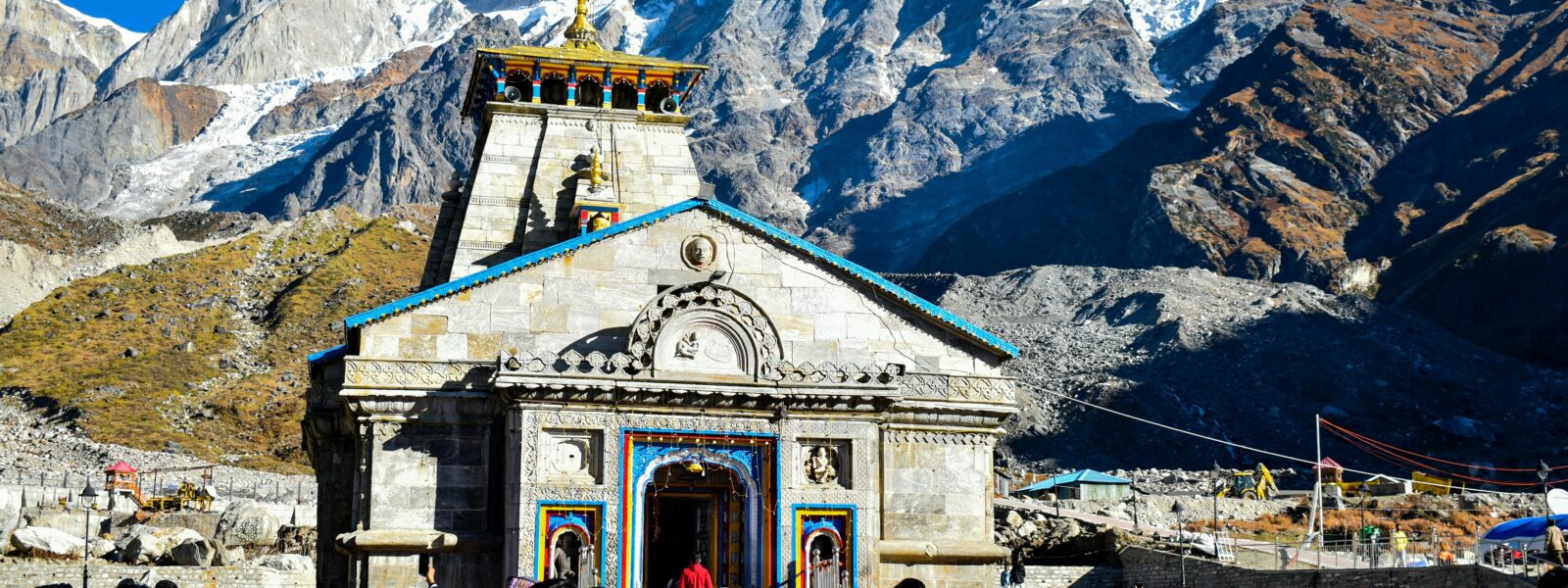Kedarnath is one of India’s most sacred Char Dham pilgrimage sites. Beyond the famous Kedarnath Temple, this divine destination offers breathtaking treks, serene lakes, and hidden spiritual spots. Whether you’re a pilgrim, adventurer, or nature lover.
Here Are The 12 Best Places To Explore in Kedarnath
1. Kedarnath Temple – The Sacred Jyotirlinga
Distance from Gaurikund: 16 km trek
The Kedarnath Temple, dedicated to Lord Shiva, is one of the 12 Jyotirlingas. Built by the Pandavas and revived by Adi Shankaracharya, this stone temple stands strong against harsh Himalayan weather.
Highlights:
Evening Aarti – A soul-stirring experience with chanting and lamps.
Winter Abode – The deity is moved to Ukhimath (Nov-Apr) due to heavy snow.
Architecture – Massive stone slabs with intricate carvings.
Best Time to Visit: May to October (temple opens on Akshaya Tritiya).
2. Adi Shankaracharya Samadhi – The Philosopher’s Final Resting Place
Location: Behind Kedarnath Temple
This sacred spot marks where Adi Shankaracharya, the saint who revived Hinduism, attained maha samadhi (eternal meditation) at age 32.
Why Visit?
Peaceful Vibes – Ideal for meditation.
Historical Significance – Learn about his teachings.
3. Bhairav Nath Temple – The Guardian of Kedarnath Distance: 500m from main temple
Bhairav Nath (Shiva’s fierce form) is believed to protect Kedarnath when the temple is closed in winter.
Highlights:
Short Trek – Offers panoramic Himalayan views.
Unique Ritual – Priests perform special pujas here.
4. Vasuki Tal – A High-Altitude Glacial Lake
Trek Distance: 8 km from Kedarnath (4,150m altitude)
This stunning emerald-green lake is surrounded by snow peaks and is a challenging but rewarding trek.
Why Visit?
Adventure – Ideal for trekkers and photographers.
Mythology – Named after the serpent king Vasuki.
5. Gandhi Sarovar (Chorabari Tal) – The Sacred Lake
Distance: 3 km from Kedarnath
A serene lake where Mahatma Gandhi’s ashes were immersed. The Chorabari Glacier feeds this waterbody.
Highlights:
Tranquil Spot – Perfect for quiet reflection.
Snow Views – Surrounded by Himalayan giants.
6. Gaurikund – The Gateway to Kedarnath
Base Village: Where the trek begins
This hot water spring is named after Goddess Parvati, who meditated here to win Lord Shiva’s heart.
What to Do?
Holy Dip – Believed to purify the soul.
Last Motorable Point – Start your trek from here.
7. Sonprayag – The Confluence of Sacred Rivers
On the Way to Gaurikund
Where Mandakini and Basuki rivers meet, making it a spiritually significant stop.
Highlights:
Ritual Bath – Pilgrims take a dip before proceeding.
Scenic Beauty – Lush green valleys and river views.
8. Ukhimath – Winter Home of Kedarnath’s Deity
Distance: 41 km from Kedarnath
During winters, Lord Kedarnath is worshipped here. Also known as “Omkareshwar Temple.”
Why Visit?
Spiritual Hub – Hosts many small temples.
Less Crowded – Peaceful alternative to Kedarnath.
9. Rudra Meditation Cave – A Unique Spiritual Retreat
Near Kedarnath Temple
Built for deep meditation, this cave offers complete silence for seekers.
Highlights:
Energy Spot – Many report heightened spiritual experiences.
Advanced Booking Needed – Limited slots available.
10. Sumeru Parbat – The Himalayan Giant
Visible from Kedarnath
A majestic peak (6,220m) considered sacred in Hindu texts.
Why Trekkers Love It?
Challenging Climb – For expert mountaineers.
Mythological Link – Believed to be a stairway to heaven.
11. Mayali Pass – A Thrilling Trekking Route
Connects Kedarnath to Gangotri
A high-altitude pass (5,300m) offering breathtaking views of Kedarnath Dome & Chaukhamba peaks.
Best For:
Adventure Seekers – Requires proper gear and guides.
Remote Beauty – Untouched Himalayan landscapes.
12. Kedarnath Wildlife Sanctuary – Spot Rare Himalayan Species
Spread Around Kedarnath Region
Home to snow leopards, musk deer, and monal birds.
Highlights:
Nature Trails – Great for wildlife photographers.
Alpine Flora – Rare medicinal herbs grow here.

